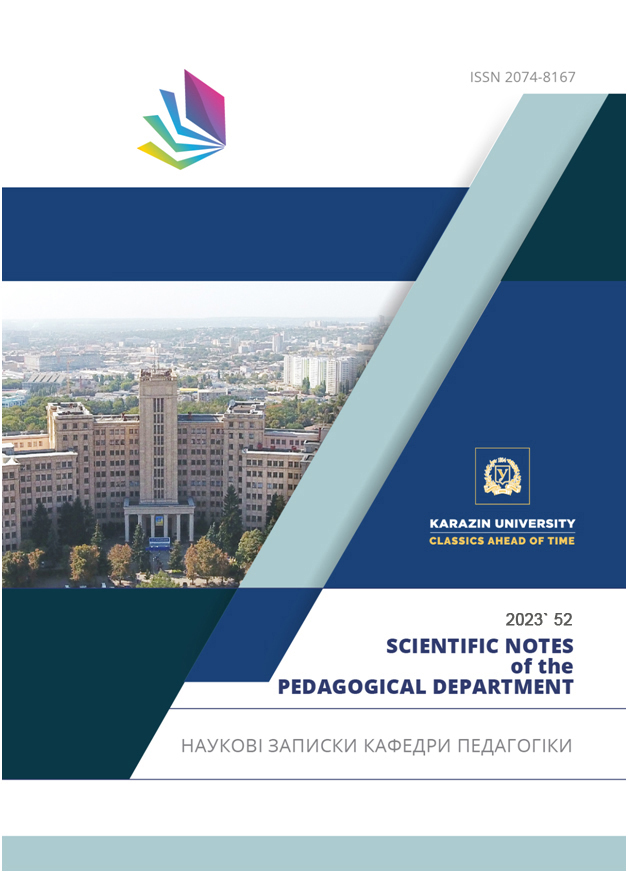Ways of organizing the educational process of academically gifted students in higher education institutions of China
Abstract
In the process of identifying capable and academically gifed students in Chinese higher education
institutions and students in secondary comprehensive schools, it is possible to go in several directions:
The first of them is the diagnosis of the abilities of students whom we classify as academically gifted.
The second direction in the research of scientists, related to finding the criteria of giftedness, is based
on three component spheres of personality - cognitive, emotional-effective and psychomotor.
Downloads
References
Alfimov, V. M. & Perepadia, D. O. (2020). eculiarities of training teachers to work with gifted children in the People’s Republic of China. Spirituality of the individual: methodology, theory and practice. 97, 4. 6-16. [in Ukrainian].
Ievtukh, M. B. (2017). Giftedness: approaches to finding out the essence. Pedagogical almanac. 36. 10-19. [in Ukrainian].
Muzyka, O. O. (2017). Axiogenesis and the development of self-efficacy of students with signs of giftedness. Actual problems of psychology: Collection of scientific works of the Kostyuk Institute of Psychology of the National Academy of Sciences of Ukraine. 6, 16. 181-192. [in Ukrainian].
Naumenko, S. S. (2021). Origins of the idea of education and upbringing of gifted children in China. Theory and methodology of education and upbringing. 50. 136-143. [in Ukrainian].
Naumenko, S. S. (2021). Pedagogical dimension of the concept of giftedness in the People’s Republic of China. Scientific journal of the Black Sea Research Institute of Economics and Innovation. Series: “Innovative pedagogy”. 35. 40–44. [in Ukrainian].
Naumenko, S. S. (2021). Specialized educational institutions for gifted children of the People’s Republic of China. [in Ukrainian].
Perepadia, D. O. (2013). Stimuli for the development of giftedness in children in China. [in Ukrainian].
Poluboiaryna, I. I. (2020). Musical giftedness in the works of foreign researchers. Professional Art Education. 1(1). 17–22. [in Ukrainian].
Chen T. (2016). Comparison of the characteristics of formal and informal education. Bulletin of Nanjing Pedagogical University. 3. 12-16. [in Ukrainian].
Chzhan M. (2013). Scientific understanding of the status and role of non-formal and additional education.
Chinese Academic Journal of Education. 3. 11-15. [in Ukrainian].
Dai, D.Y. & Steenbergen-Hu S. (2015). Special class for the gifted young: A 34-year experimentation with early
college entrance programs in China. Roeper Review. 37, 9–18.
Dai, D.Y., Steenbergen-Hu, S. & Yang, Y. (2016). Gifted education in Mainland China: How it serves a national interest and where it falls short. Gifted education in Asia: Problems and prospects. Charlotte NC. Information Age Publishing. 51–76.
Gong, H. & Lei, J. (2015). The progress and enlightenment of psychological researches on supernormal children. A Journal of Modern Special Education. 4. 23–29.
Jia, Q. & Ericson D. P. (2017). Equity and access to higher education in China: Lessons from Hunan province for university admissions policy. International Journal of Educational Development. 52. 97-110.
Kitano, M. K. (2021). Issues in research on Asian American gifted students. Special Populations in Gifted Education. 3-25.
KPMG. Education in China. URL: https://www. kpmg.de/docs/Education-inChina-201011.pdf (дата звернення 06.01.2023).
Rimm, S. B., Siegle, D. & Davis, G. A. (2018). Education of the gifted and talented. Boston. 233-236. 18. Tran, H. N. et al. (2021). Principal Leadership and Teacher Professional Development in a Vietnamese High School for Gifted Students: Perspectives into Practice. European Journal of Educational Research. 10, 4. 1839- 1851.
Wang, J. & He J. (2013). Innovative perspectives and scientific nurturing of talents – a brief introduction to the gifted education of Beijing no.8 high school. Education of Innovative Talents. 28–31.
Zhang, B., Li, J. & Xu, C. (2014). The developmental differences of problem solving ability between intellectually-gifted and intellectually-average children aged from 11-14 years old. Acta Psychologica Sinica, 46. 1823–1834

